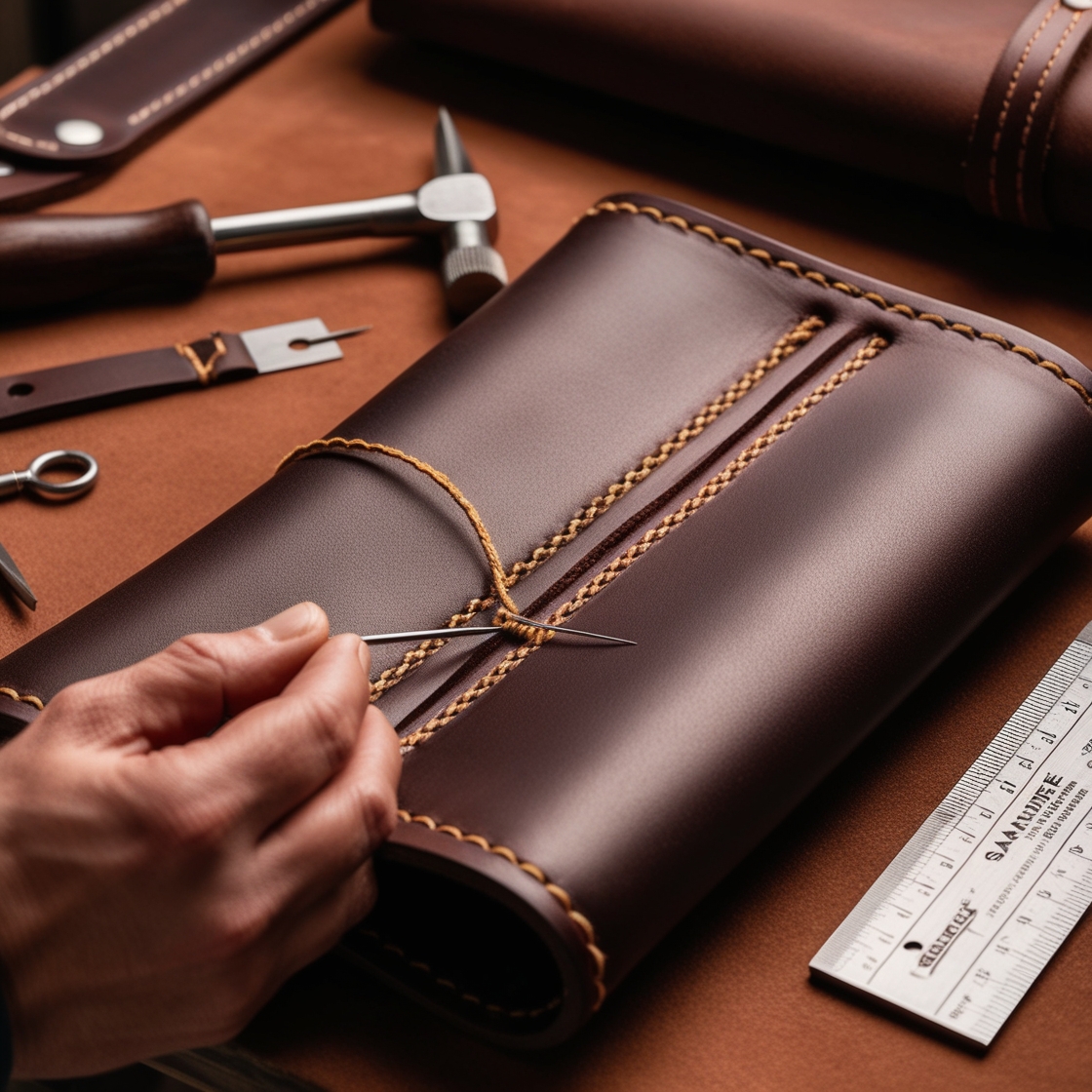Leather crafting is an art that demands precision and skill. One of the most crucial techniques for creating strong, durable seams is saddle stitching. This hand-sewing method ensures that your leather projects are not only beautiful but also built to last. In this guide, we’ll explore the essentials of saddle stitching and how it can elevate the quality of your leather goods.
What is Saddle Stitching?
Saddle stitching is a traditional hand-sewing technique that involves using two needles and a length of waxed thread. This method creates exceptionally strong seams by ensuring each stitch passes through the leather twice. Let’s dive deeper into the benefits and process of saddle stitching.
Benefits of Saddle Stitching
- Unmatched DurabilitySaddle stitching is renowned for its strength. Because each stitch penetrates the leather twice, it creates a sturdy seam that can withstand heavy use. This durability makes saddle stitching ideal for leather items like belts, bags, and wallets.
- Precise and SecureThis technique provides a consistent and secure stitch line. The use of two needles allows for precise stitching, ensuring that each seam is tight and uniform. This attention to detail enhances the overall quality of your leather project.
- Professional FinishSaddle stitching offers a clean, professional appearance. The evenly spaced stitches contribute to a polished look, making your leather goods stand out. This method not only improves the aesthetics but also adds to the longevity of the item.
Essential Tools for Saddle Stitching
To achieve the best results with saddle stitching, you’ll need a few essential tools:
- NeedlesPurpose: Saddle stitching requires two needles, one for each end of the thread. These needles should be sharp and strong to penetrate the leather smoothly.Usage Tip: Ensure the needles are appropriately sized for the thread and leather thickness to avoid difficulties during stitching.
- Waxed ThreadPurpose: The waxed thread used in saddle stitching is designed to be durable and provide a strong bond. The wax coating helps the thread glide through the leather and resist fraying.Usage Tip: Choose a thread thickness that matches the weight of the leather for a balanced and sturdy seam.
- Stitching AwlPurpose: A stitching awl is used to create holes in the leather for the needles. It helps ensure that the stitches are evenly spaced and accurately aligned.Usage Tip: Use a stitching awl to create holes that are slightly smaller than the needle to achieve a tight fit.
- Ruler and Wing DividerPurpose: These tools help mark and measure the stitching line, ensuring evenly spaced stitches and a straight seam.Usage Tip: Measure and mark the stitching line before starting to maintain consistency throughout the project.
Read more about How to Dye & Paint Leather: Tips for Stunning
Step-by-Step Guide to Saddle Stitching
Follow these steps to master the art of saddle stitching:
- Prepare the LeatherBefore stitching, ensure the leather is clean and smooth. Use a ruler and wing divider to mark the stitching line and spacing.Tip: Use a stitching awl to create evenly spaced holes along the marked line.
- Thread the NeedlesCut a length of waxed thread and thread a needle on each end. The thread should be long enough to complete the seam without frequent rethreading.Tip: Wax the thread slightly before use to enhance its durability and ease of handling.
- Begin StitchingInsert one needle from one side of the leather and the other needle from the opposite side. Pull the needles through the holes simultaneously, crossing them in the middle of the leather.Tip: Maintain consistent tension on the thread to avoid loose or uneven stitches.
- Secure the StitchAfter completing the seam, tie a knot on the inside of the leather to secure the stitches. Trim any excess thread.Tip: Burn the thread ends slightly to prevent fraying and add a polished finish.
Stamp & Tool Leather: Adding Decorative Elements
After perfecting your saddle stitching, consider incorporating decorative elements with stamping and tooling techniques. These methods can enhance the visual appeal of your leather projects by adding unique patterns and designs.
- Stamping LeatherPurpose: Leather stamping involves using metal stamps to create impressions or patterns on the surface of the leather. This technique adds texture and design elements to your projects.Usage Tip: Heat the stamp slightly before applying it to the leather for clearer impressions. Ensure the leather is damp to achieve better results.
- Tooling LeatherPurpose: Tooling involves carving or embossing designs into the leather using specialized tools. This technique allows for intricate designs and can be used to personalize your leather items.Usage Tip: Practice your designs on scrap leather first to perfect your technique before applying it to your final project.
Conclusion
Saddle stitching is a timeless technique that ensures strong, durable seams in leather crafting. By mastering this method, you can create high-quality leather goods that not only look professional but also stand the test of time. Additionally, incorporating stamping and tooling techniques can further enhance the aesthetic appeal and uniqueness of your leather projects. With the right tools and techniques, your leather creations will shine with both strength and elegance.
Explore our collection of leather stitching, stamping, and tooling tools to get started. Embrace these traditional techniques and elevate your leather crafting to new heights.
